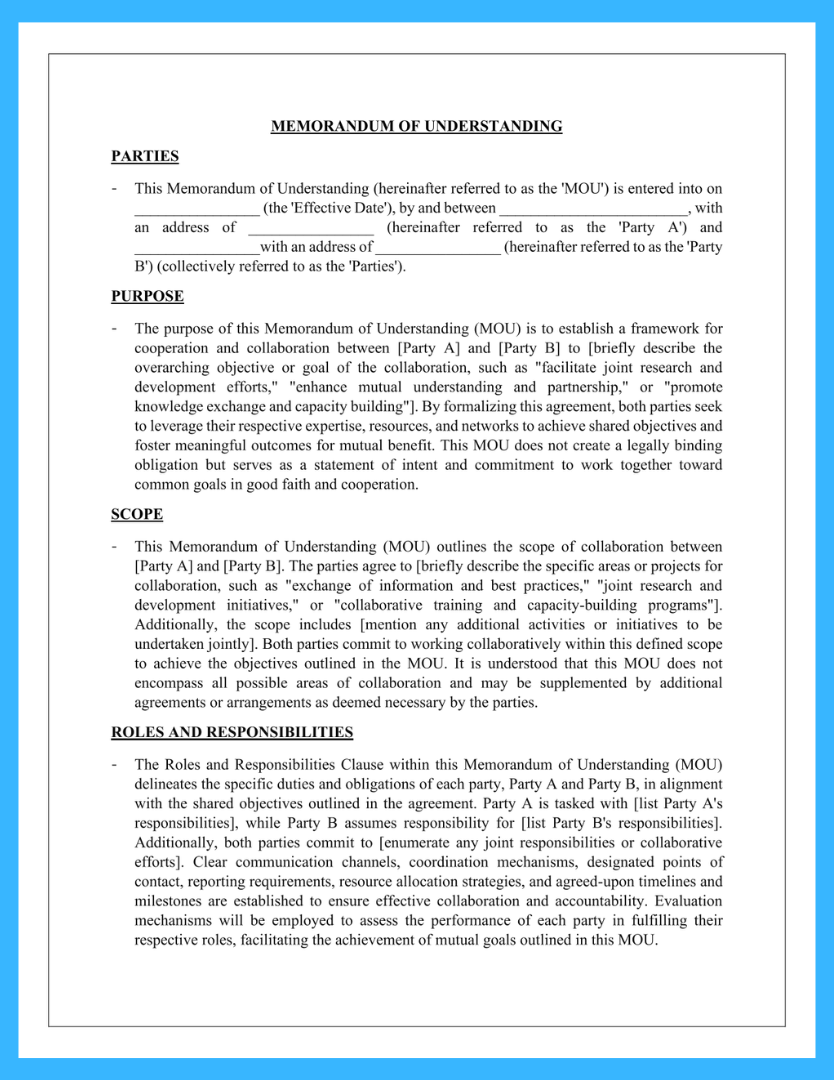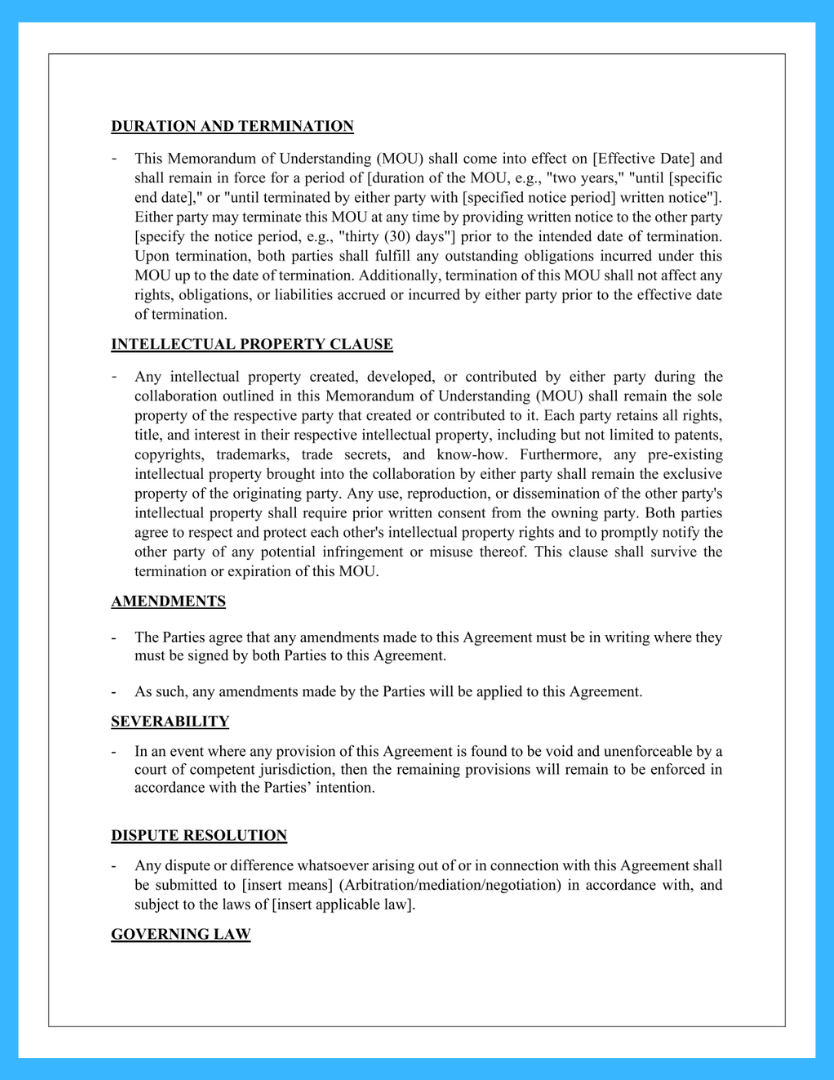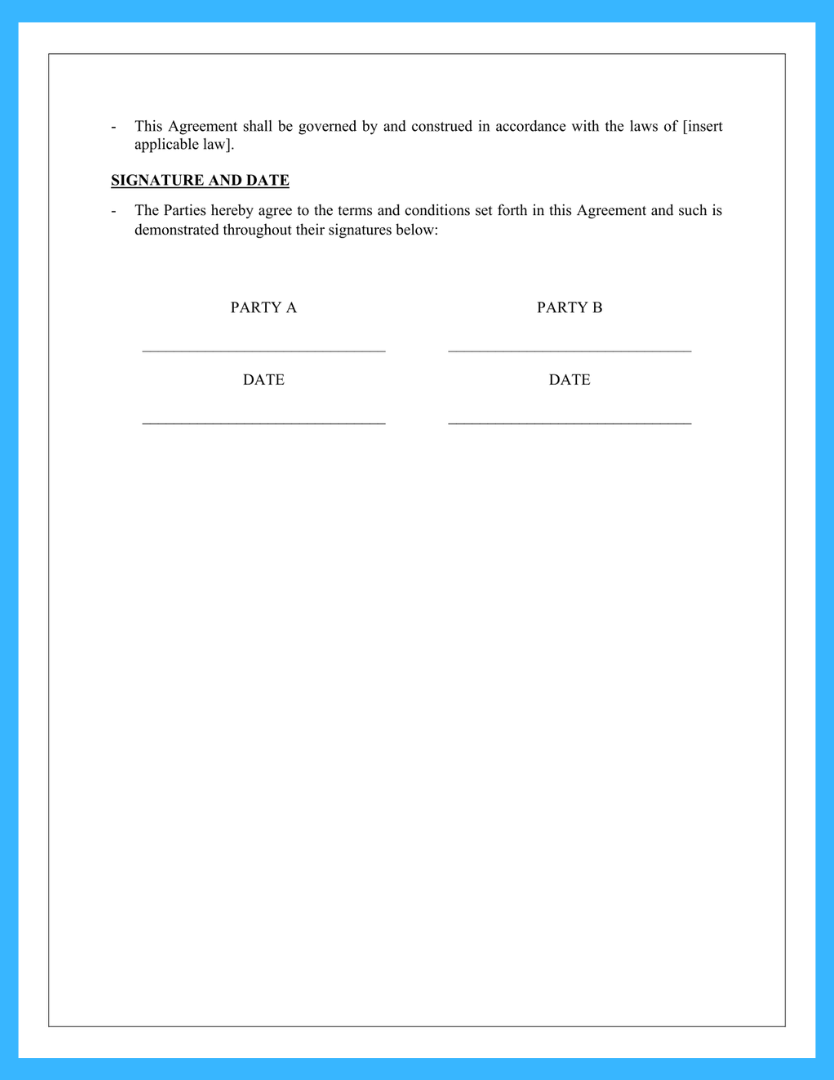Free Memorandum of Understanding Template
A memorandum of understanding (MOU) is an important document to set expectations between two or more parties working together on a project or business deal.



What is a Memorandum of Understanding?
A memorandum of understanding is a written document outlining an agreement between two or more parties. The purpose of an MOU is to clearly lay out the details and terms that all parties agree upon regarding a specific partnership, project, transaction, or cooperation. While not always legally binding, a memorandum of understanding sets clear expectations and responsibilities for the parties involved. This type of agreement can be legally binding when both parties agree to specific contractual language in the written agreement.
MOUs are common in business deals, nonprofit ventures, government agency partnerships, and other situations where two or more organizations need to cooperate on an effort or transaction. The signed MOU allows the parties to detail negotiated provisions and terms so all groups are on the same page moving forward.
When to Use a Memorandum of Understanding Template
A memorandum of understanding template comes in handy when two or more parties acknowledge that they anticipate working together on an effort or project and want to outline details and expectations in writing beforehand.
For example, an MOU template can be used when two companies or organizations plan to partner on a business venture, intellectual property research, transaction, sponsorship, research project, or shared resource development. Nonprofits often use MOUs when collaborating with other nonprofits, committees, or government agencies on initiatives.
A memorandum of understanding template ensures that all parties understand their rights and responsibilities in the partnership. It also provides legal documentation that can be referred to throughout the term of the agreement. Having clearly outlined expectations and provisions in an MOU sets partnerships up for success and prevents potential misunderstandings.
What to Include in a Memorandum of Understanding
A comprehensive memorandum of understanding template should contain several key sections covering all necessary details about the partnership, expectations, and negotiated terms.
Party Information
Identifying the two parties involved is essential in an MOU. This section lists the full legal names and addresses of all organizations or individuals entering into the agreement. Include company registration numbers, nonprofit status, or other official credentials to validate the entities. Listing contact information for key representatives from each party is also essential.
Purpose of MoU
The purpose statement in a memorandum of understanding template summarizes why the parties choose to collaborate and what their partnership’s main objectives or goals entail. It outlines the shared mission that makes the MOU necessary and sets the stage for the following details. An example purpose could be two nonprofits forming an MOU to coordinate resources for expanding local food access.
Objective Descriptions
While the purpose sets the overall intention, the objectives section gets more detailed about the specific projects, transactions, resource sharing, roles, and timelines involved. The objectives outline what all parties agree to contribute and achieve. In the food access example, objectives could include opening a joint food pantry by a specific date, fundraising goals, and volunteer sharing. Concrete objectives make responsibilities clear.
Rights & Responsibilities
The rights and responsibilities section explicitly states what each partner can expect from the others according to the MOU terms. This part includes organizational rights regarding decision-making,resource usage and individual responsibilities of key staff carrying out the MOU.
Detailing these rights and duties protects parties and holds them accountable. For example, the food banks may have the right to share branding, while each staff member is responsible for coordinating monthly inventory counts or volunteer schedules.
Terms of Agreement
The terms of agreement section lays out the duration expectations for the MOU. This part includes the partnership’s start and end date and requirements for renewing or modifying the agreement. Having predetermined terms prevents confusion between parties about whether their collaboration has officially ended. The section also covers the procedures for early termination, addressing violations, withdrawing participation, and resolving disputes.
General Terms
General terms capture any remaining policies about the overall MOU like:
- Confidentiality: Non-disclosure agreement rules regarding sensitive information.
- Amendments: Process for making modifications mid-term.
- Governing law: Name which state or country’s laws govern the agreement.
- Notices: Acceptable means of formal communication between parties.
- Entirety: Statement that the memorandum of understanding constitutes the entire understanding.
Covering these boilerplate items formally in the general terms section ensures no questions remain about policies all parties expected but didn’t specify elsewhere.
Signatures
A signatures section uses something like the smooth e-signature service Signaturely provides to formally execute the memorandum of understanding. Listing each party’s authorized signatory role and capturing their signed name/date makes the agreement final. Digital signatures like Signaturely Integrate offer accountability without the hassle of printing, signing, scanning, and faxing. Using Signaturely to wrap up and approve an MOU also enables quick access to the final copy from anywhere, anytime.
Download our free example
Memorandum of Understanding Template
We’ve got your back here at Signaturely, and we’re ready to help make stress-free contracts a reality. Forget the confusing paperwork and overwhelming legal jargon – get easy, breezy contract templates in minutes with our free template.
Benefits of a Memorandum of Understanding Template
Using a memorandum of understanding template to outline partnerships has many advantages over loosely entering collaborations based on verbal agreements. Benefits of developing an MOU include:
- Clarifying expectations upfront prevents misunderstandings about objectives, resource allocation, and responsibilities later.
- Referring back to the memorandum of understanding provides clarity if questions ever arise down the road about the original terms.
- Written MOU terms hold parties accountable for what they agreed to contribute or achieve.
- An authorized MOU lends legitimacy and formality that encourages partners to fulfill obligations.
Having predetermined processes for modifying scope, resolving disputes, or withdrawing from the partnership protects parties if unexpected situations arise. Overall, a well-crafted memorandum of understanding template paves the way for more successful, lasting collaborations when both parties agree.
How to Create a Memorandum of Understanding With Signaturely
Drafting a professional memorandum of understanding is simple with tools like Signaturely. Select a memorandum of understanding template in Signaturely to populate an agreement outline. Customize the sections with specific partner names, objectives, terms, and other vital details. Then, upload any attachments referencing external documents. Finally, request e-signatures from all parties right within the platform.
Signaturely secures sign-off digitally without needing printouts and signed copies get stored for easy access anytime. Setup is quick, signing intuitive, and Signaturely offers excellent customer support if questions arise. Signaturely can’t be beaten in terms of ease of use and legal compliance for seamless MOU and other agreement creation, integration, and management.
FAQs About a Memorandum of Understanding Template
Memorandum of understanding templates make collaborations smoother, but questions still come up. Common MOU-related FAQs include:
How do you write a simple memorandum of understanding?
Use precise language covering the key sections. Avoid legal jargon when possible. Focus on tangible objectives and terms.
How do you structure a memorandum of understanding?
Structure a memorandum of understanding to provide clarity and direction for the involved parties. It typically starts with an introduction of the parties, the purpose of the MOU, and its scope. Follow this with detailed sections outlining roles and responsibilities, terms and conditions, timeframes, resource commitments, and any specific obligations or procedures. Including dispute resolution methods and terms for amendment or termination of the MOU is also crucial. The document should end with a section for signatures and dates.
How do I draft a MOU template?
Drafting an MOU template begins by defining the purpose and scope of the agreement. Use sample templates as a starting point and tailor them to the specifics of the partnership. Clearly outline each party’s objectives, roles and responsibilities, resources to be shared or exchanged, timelines for implementation, and policies governing the MOU. Ensure that provisions for dispute resolution, modification, and termination are included. Finally, leave space for the signatures of the authorized representatives from each party.
What is the standard memorandum of understanding?
A standard memorandum of understanding typically includes sections that identify the parties involved, state the purpose of the agreement, detail the terms and conditions, outline the responsibilities of each party, and specify the duration of the MOU. It should be clear, concise, and cover all necessary aspects of the agreement to avoid ambiguity. A standard MOU also includes clauses on confidentiality, dispute resolution, and termination procedures.
What is the difference between a MOU and an LOI?
While both documents are preliminary agreements, they have some differences. An MOU is a formal agreement between two or more parties outlining the terms and other details of an understanding, including each party’s requirements and responsibilities. It is more detailed and closer to a contract but generally not legally binding. An LOI, on the other hand, is a document that outlines the intention of one party to do business with another. It is less formal than an MOU and is often used in the early stages of negotiations, typically without detailed terms and conditions. An LOI often precedes an MOU or a formal agreement.
What You Need to Remember About a Memorandum of Understanding
MOUs are most effective when purposefully crafted to capture mutual understanding between all parties involved through clarity of goals, specifics, terms, and formal approval. Keeping these critical elements in focus when developing a memorandum of understanding (MOU) sets up collaborations for success.
Memorandum of Understanding
MEMORANDUM OF UNDERSTANDING
PARTIES
- This Memorandum of Understanding (hereinafter referred to as the ‘MOU’) is entered into on ________________ (the ‘Effective Date’), by and between ________________________, with an address of ________________ (hereinafter referred to as the ‘Party A’) and ________________with an address of ________________ (hereinafter referred to as the ‘Party B’) (collectively referred to as the ‘Parties’).
PURPOSE
- The purpose of this Memorandum of Understanding (MOU) is to establish a framework for cooperation and collaboration between [Party A] and [Party B] to [briefly describe the overarching objective or goal of the collaboration, such as “facilitate joint research and development efforts,” “enhance mutual understanding and partnership,” or “promote knowledge exchange and capacity building”]. By formalizing this agreement, both parties seek to leverage their respective expertise, resources, and networks to achieve shared objectives and foster meaningful outcomes for mutual benefit. This MOU does not create a legally binding obligation but serves as a statement of intent and commitment to work together toward common goals in good faith and cooperation.
SCOPE
- This Memorandum of Understanding (MOU) outlines the scope of collaboration between [Party A] and [Party B]. The parties agree to [briefly describe the specific areas or projects for collaboration, such as “exchange of information and best practices,” “joint research and development initiatives,” or “collaborative training and capacity-building programs”]. Additionally, the scope includes [mention any additional activities or initiatives to be undertaken jointly]. Both parties commit to working collaboratively within this defined scope to achieve the objectives outlined in the MOU. It is understood that this MOU does not encompass all possible areas of collaboration and may be supplemented by additional agreements or arrangements as deemed necessary by the parties.
ROLES AND RESPONSIBILITIES
- The Roles and Responsibilities Clause within this Memorandum of Understanding (MOU) delineates the specific duties and obligations of each party, Party A and Party B, in alignment with the shared objectives outlined in the agreement. Party A is tasked with [list Party A’s responsibilities], while Party B assumes responsibility for [list Party B’s responsibilities]. Additionally, both parties commit to [enumerate any joint responsibilities or collaborative efforts]. Clear communication channels, coordination mechanisms, designated points of contact, reporting requirements, resource allocation strategies, and agreed-upon timelines and milestones are established to ensure effective collaboration and accountability. Evaluation mechanisms will be employed to assess the performance of each party in fulfilling their respective roles, facilitating the achievement of mutual goals outlined in this MOU.
DURATION AND TERMINATION
- This Memorandum of Understanding (MOU) shall come into effect on [Effective Date] and shall remain in force for a period of [duration of the MOU, e.g., “two years,” “until [specific end date],” or “until terminated by either party with [specified notice period] written notice”]. Either party may terminate this MOU at any time by providing written notice to the other party [specify the notice period, e.g., “thirty (30) days”] prior to the intended date of termination. Upon termination, both parties shall fulfill any outstanding obligations incurred under this MOU up to the date of termination. Additionally, termination of this MOU shall not affect any rights, obligations, or liabilities accrued or incurred by either party prior to the effective date of termination.
INTELLECTUAL PROPERTY CLAUSE
- Any intellectual property created, developed, or contributed by either party during the collaboration outlined in this Memorandum of Understanding (MOU) shall remain the sole property of the respective party that created or contributed to it. Each party retains all rights, title, and interest in their respective intellectual property, including but not limited to patents, copyrights, trademarks, trade secrets, and know-how. Furthermore, any pre-existing intellectual property brought into the collaboration by either party shall remain the exclusive property of the originating party. Any use, reproduction, or dissemination of the other party’s intellectual property shall require prior written consent from the owning party. Both parties agree to respect and protect each other’s intellectual property rights and to promptly notify the other party of any potential infringement or misuse thereof. This clause shall survive the termination or expiration of this MOU.
AMENDMENTS
- The Parties agree that any amendments made to this Agreement must be in writing where they must be signed by both Parties to this Agreement.
- As such, any amendments made by the Parties will be applied to this Agreement.
SEVERABILITY
- In an event where any provision of this Agreement is found to be void and unenforceable by a court of competent jurisdiction, then the remaining provisions will remain to be enforced in accordance with the Parties’ intention.
DISPUTE RESOLUTION
- Any dispute or difference whatsoever arising out of or in connection with this Agreement shall be submitted to [insert means] (Arbitration/mediation/negotiation) in accordance with, and subject to the laws of [insert applicable law].
GOVERNING LAW
- This Agreement shall be governed by and construed in accordance with the laws of [insert applicable law].
SIGNATURE AND DATE
- The Parties hereby agree to the terms and conditions set forth in this Agreement and such is demonstrated throughout their signatures below:
PARTY A |
PARTY B _______________________________ |
DATE
_______________________________
|
DATE
_______________________________ |
Download Our Free Memorandum of Understanding Template Today
Don’t waste any more time trying to craft the perfect memorandum of understanding. Our memorandum of understanding template is ready and ready to download in one quick, convenient click—no more complicated documents for you or your clients to fill out.
Just download, customize, and off you go!